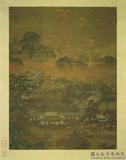宋郭忠恕摹顧愷之蘭亭讌集圖 卷
推薦分享
資源連結
連結到原始資料 (您即將開啟新視窗離開本站)後設資料
- 資料識別:
- 故畫001397N000000000
- 資料類型:
- 類型:繪畫
- 型式:靜態圖像
- 著作者:
- 郭忠恕
- 主題與關鍵字:
- 高士(士人、隱士) 侍從(侍女、童僕) 楊柳 水榭 溪澗、湍泉 江河、湖海 松 竹 芭蕉 鵝 橋 傢俱(屏風) 飲食器 文房用具
- 出版者:
- 數位化執行單位:國立故宮博物院
- 格式:
- 本幅 23.5x711.8公分、隔水一 14.7公分、隔水二 14.8公分、隔水三 12公分、隔水四 14.7公分、拖尾 23.5x153.4公分
- 關聯:
- 石渠寶笈初編(御書房),下冊,頁1045&*故宮書畫錄(卷八),第四冊,頁30&*故宮書畫圖錄,第十五冊,頁183-190&*為了完整表達曲水流觴故事,採取長卷的布局是最容易的。首段畫王羲之於蘭亭內倚案停筆,正是思考如何下筆,接著,隨著蜿蜒的小水渠,人物置於兩旁,坐者、倚者、盤腿者,持杯飲酒、持紙將書、支頤沉思,各盡其態。又將各人名爵里地及當時所作詩篇,列於人物之旁。圖文並呈,形式上是一種畫中有詩、詩中有畫,著重於故事說明性。本幅有「忠恕」款,就畫風實與郭忠恕(九七七年卒)無關。&* One convenient way to illustrate the Orchid Pavilion gathering is with floating wine cups on a winding stream (and then depicting it in the composition of a long handscroll). The first section represents Wang Hsi-chih sitting at a table holding a brush in the Orchid Pavilion, pondering on his passage. Then, on either side of a winding stream, figures sit, lean, drink, write, and are deep in thought. Transcribed by each is the verse he composed. Combining word and image to create “painting in poetry” and “poetry in painting” thus adds a narrative effect. The signature of “Chung-shu,” for the 10th-century artist Kuo Chung-shu appears here, but the style is unrelated to his.&* 東晉永和九年(三五三),王羲之和友人在浙江會稽山陰的蘭亭舉行修禊雅集,賦詩倡和,王羲之作序並書,即是著名的「蘭亭序」。據記載,參與這次雅集的,包括王羲之子獻之,共四十二人,有人成詩兩篇,有人一篇,不成詩的,罰酒三杯。 此圖繪四十二人,分坐曲水兩側,有的提筆而書,有的沉吟苦思,各盡其態。人物旁以楷書標記官職姓名及所作詩。卷後有正德六年(一五一一)何旭題跋。
- 管理權:
- 國立故宮博物院
授權聯絡窗口
- 國立故宮博物院圖像授權、出版授權、影音資料授權-申請流程說明
http://www.npm.gov.tw/zh-TW/Article.aspx?sNo=03003061






